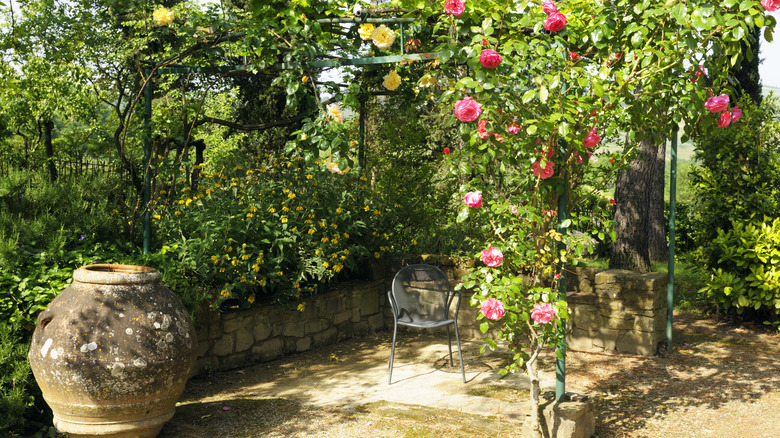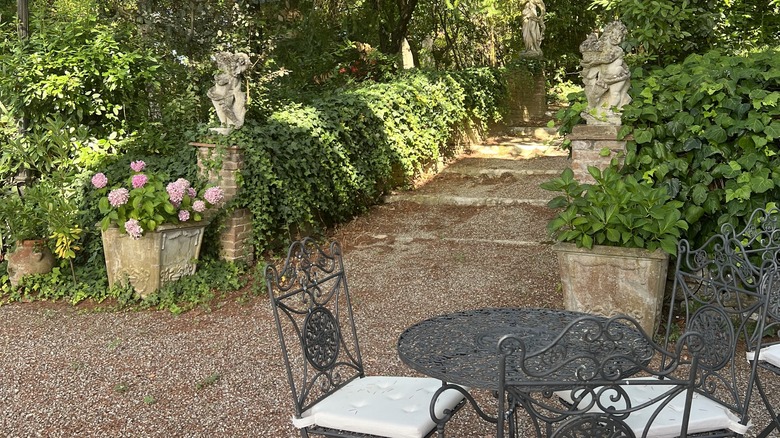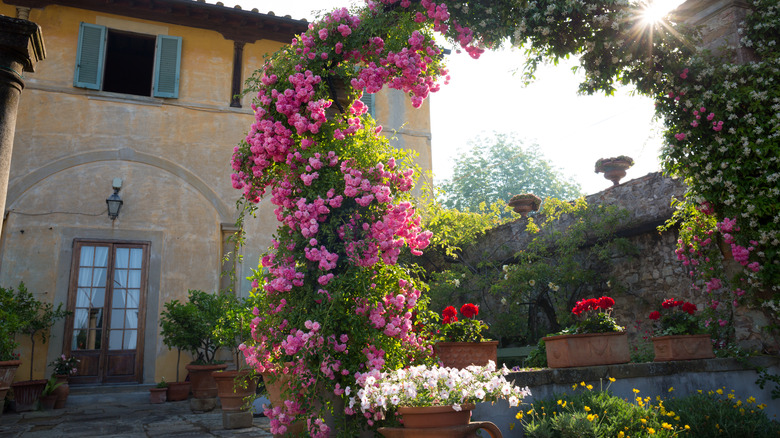The Beautiful Backyard Design Aesthetic That Happens To Be Low-Maintenance
If you've been lucky enough to travel through Southern Italy, you know there are few places with gardens so spectacularly designed anywhere else in the world. Tuscan gardens are known for their lush plants, architectural elements, as well as the incorporation of art pieces such as fountains, statues, and other fixtures. The region's Garden of Villa Garzoni and Villa La Foce are two iconic examples. Since Tuscan landscaping is so timeless and celebrated, it may surprise you to learn that it is actually relatively low-maintenance, and creating your own oasis in your backyard is not as difficult as you might think.
For one, Tuscan gardens don't require pristine lawns or fussy flower beds. Instead, you'll find the foundations of them to be made of stone, gravel, bricks, and other low-maintenance terrains, sometimes using nothing more than dirt itself. Plus, the plants that help Tuscan gardens perfectly blend classical ornateness and untamed beauty happen to be low-maintenance as well. Here's how to create a little piece of Tuscany in your own yard, and enjoy the benefits of this relaxed gardening style.
Getting a low-maintenance Tuscan garden started
As with many low-maintenance projects, they don't start out easy, and the high-maintenance phase of designing a Tuscan-style landscaping is at the beginning. That's partially because they are very different from most American gardens, so you'll need to make some pretty big changes to the yard. Grass can be incorporated into Tuscan gardens if you are attached to your lawn. But, this can also be a good time to remove that water-hogging grass and try a drought-proof xeriscape in your garden. Xeriscaping is common in Mediterranean gardens, favoring stone, bricks, and gravel over neat green lawns. You can limit it to garden beds and a pathway or expand it to the majority of the yard.
The other element to establishing a Tuscan garden is what's known as hardscaping. This includes components that aren't natural, like benches, fountains, urns, sculptures, and so on. Try not to overdo this, as it can quickly look tacky. Look for large terracotta planters, stone columns, and wrought-iron patio furniture for a tasteful touch. Once you have your Mediterranean plants rooted and well-established, you can wind them through the hardscape items to make them look more natural and authentic. Not only do these elements, combined with the rock, stone, or brick landscaping look stunning, but they also mean you'll spend less time dealing with fussy grass.
What plants to include in a Tuscan garden
No garden is complete without plants, of course, and the Tuscan garden is no exception. You'll want to take inspiration from actual Tuscan landscapes and stick to Mediterranean plants for your garden. That's because much of the flora of the region is incredibly hardy, drought-resistant, and requires only basic upkeep.
One of the most iconic choices has got to be the cypress tree, which are a coniferous evergreen that do well in high-heat zones. They look lovely scattered in the garden amongst low-lying shrubs, or as privacy plants around the patio. Try to include some Mediterranean herbs such as rosemary and thyme, both of which flower and are edible as well. Plus, these are both hardy, require little upkeep, and do well with only occasional watering. Of course, perhaps second and third to cypress trees, lemon and olive trees are also quintessentially Tuscan. However, buying full-size trees is very expensive, so you may opt to try using immature plants that start in pots.
For pops of color, add Jerusalem sage (Phlomis fruticosa), which provides sunshiny yellow flowers and is a low-maintenance plant that can be planted in flower borders and garden beds. Bougainvillea is another option, that has can be trained to grow on hardscape structures and features an iconic Tuscan vibe. Jasmine, often readily available at garden centers, is another great choice that will fill your outdoor space with its sweet fragrance.


